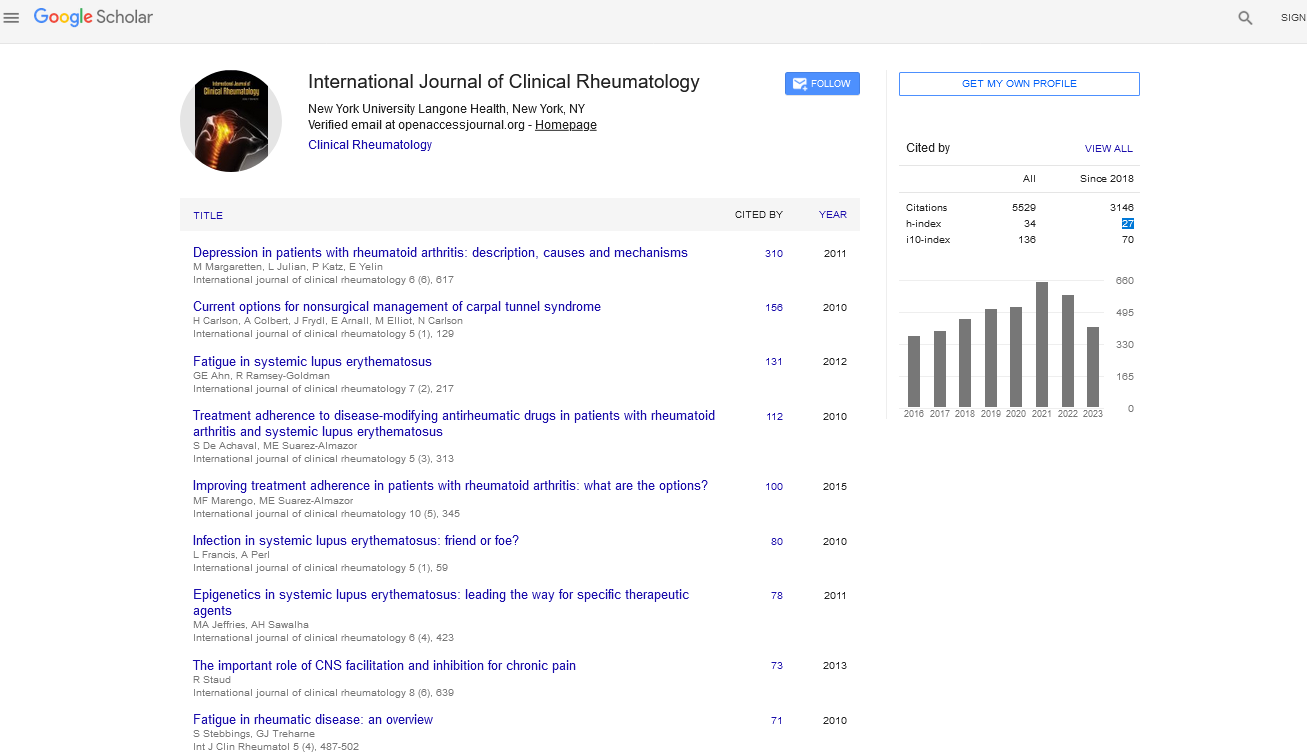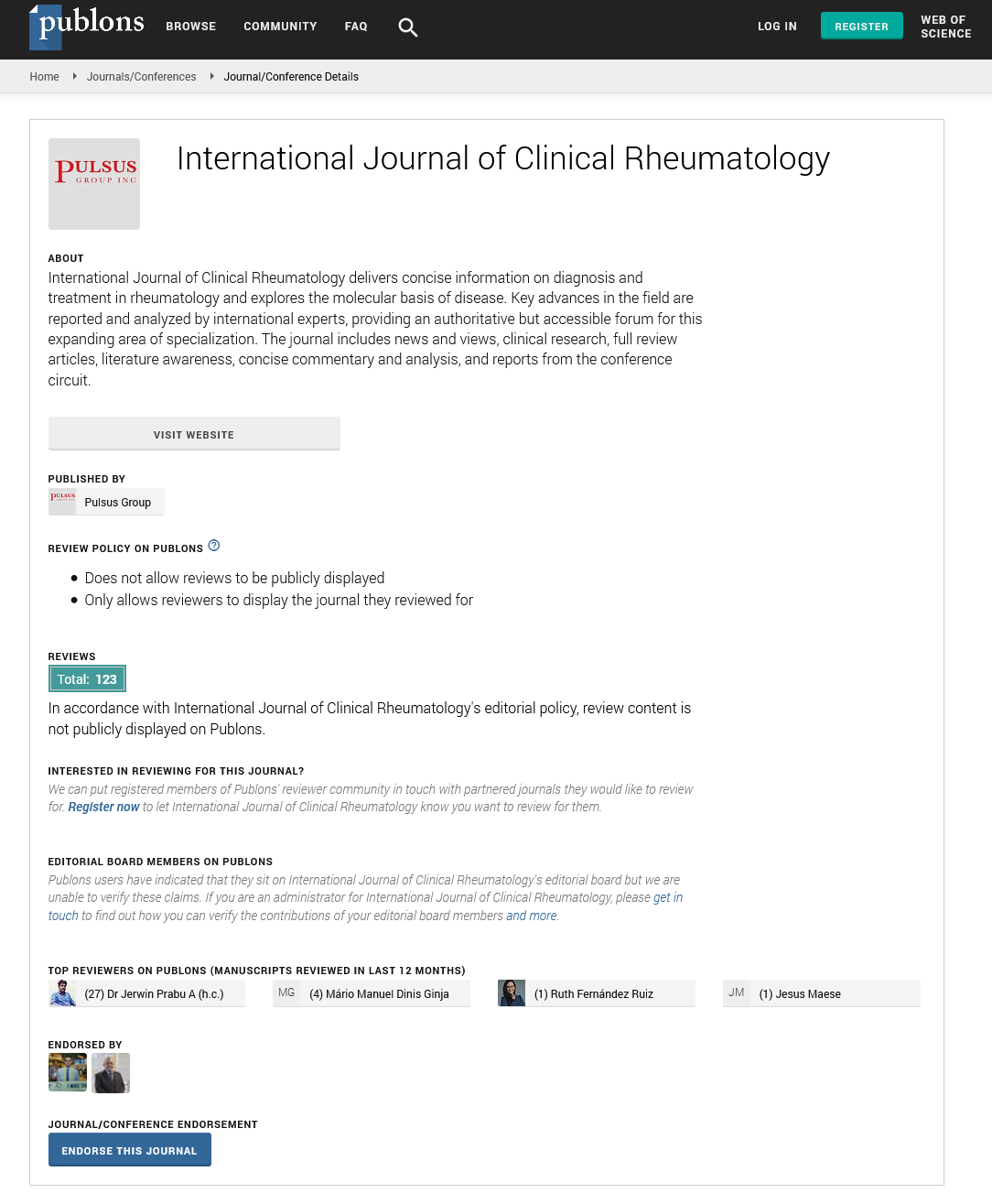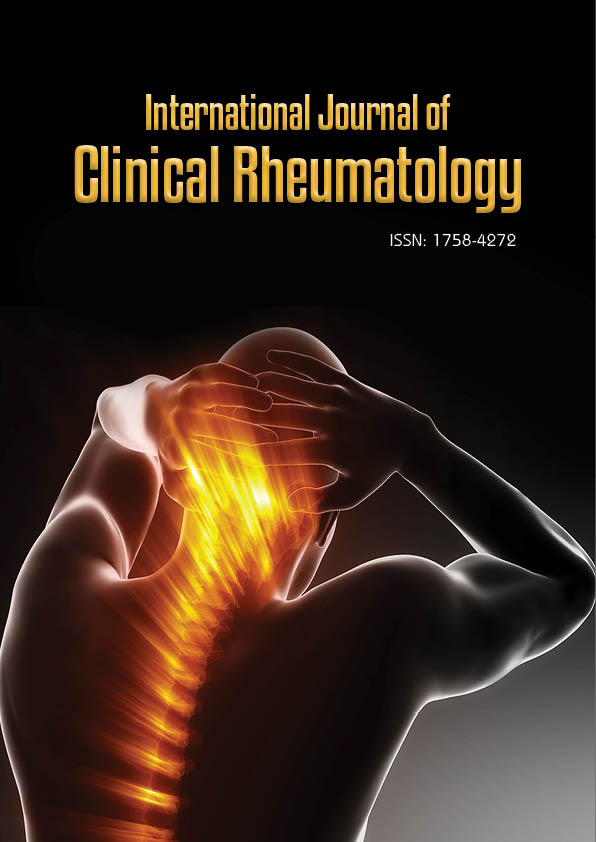Commentary - International Journal of Clinical Rheumatology (2025) Volume 20, Issue 1
Challenges in Managing Systemic Lupus Erythematosus: Current Treatment Strategies and Future Directions
Emma Scott*
Department of Rheumatology, All India Institute of Medical Sciences (AIIMS), New Delhi
- *Corresponding Author:
- Emma Scott
Department of Rheumatology, All India Institute of Medical Sciences (AIIMS), New Delhi
E-mail: emma.scott54@live.com
Received: 02-Jan-2025, Manuscript No. fmijcr-25-162965; Editor assigned: 04- Jan-2025, Pre-QC No. fmijcr-25-162965 (PQ); Reviewed: 18-Jan-2025, QC No. fmijcr-25-162965; Revised: 23-Jan-2025, Manuscript No. fmijcr-25-162965 (R); Published: 30-Jan-2025, DOI: 10.37532/1758- 4272.2025.20(1).377-379
Abstract
Systemic lupus erythematosus (SLE) is a chronic autoimmune disease characterized by multisystem involvement, including the skin, joints, kidneys, and cardiovascular system. The management of SLE remains a challenge due to its heterogeneous nature and the variability of disease severity. This article reviews current treatment strategies for SLE, including glucocorticoids, immunosuppressive agents, and newer biologic therapies, and discusses emerging treatment options and the need for personalized management.
Keywords
Rheumatoid arthritis (ra) • Early diagnosis • Biomarkers • Anti-citrullinated protein antibodies (acpa) • Rheumatoid factor (rf) • C-reactive protein (crp) • Imaging techniques
Introduction
Systemic lupus erythematosus (SLE) is a complex autoimmune disease with a wide array of clinical manifestations. The unpredictable nature of the disease, with periods of flare and remission, presents a challenge for clinicians. While treatments such as corticosteroids and immunosuppressive agents have been used for decades, they are often associated with significant side effects, particularly when used long-term. Newer biologic therapies and targeted treatments have expanded the therapeutic options for SLE patients, but more research is needed to optimize care and improve outcomes [1-3].
Biomarkers in the early detection of rheumatoid arthritis
Biomarkers are substances that can be measured in the blood, urine, or other bodily fluids and are indicative of the presence or progression of a disease. In the case of RA, the most important biomarkers include rheumatoid factor (RF) and anti-citrullinated protein antibodies (ACPA). RF is an antibody that targets the Fc portion of immunoglobulin G, while ACPA specifically targets citrullinated proteins, which are generated during inflammation. ACPA has become a critical biomarker for early RA diagnosis due to its high specificity. Studies have shown that ACPA can be detected years before the clinical onset of RA, making it a valuable tool for identifying individuals at risk. Alongside ACPA, the presence of RF further increases diagnostic accuracy. However, RF is less specific as it is also present in other autoimmune diseases, such as Sjögren’s syndrome and systemic lupus erythematosus, as well as in healthy individuals. Another emerging biomarker is C-reactive protein (CRP), an acute-phase reactant that increases in response to inflammation. Elevated CRP levels, along with clinical signs of inflammation, can suggest the presence of RA or other inflammatory arthropathies. Combining these biomarkers with clinical assessment has made it easier to diagnose RA at earlier stages [4-6].
Imaging techniques for early detection of rheumatoid arthritis
While biomarkers provide valuable diagnostic information, imaging plays an equally important role in the early identification of RA. Traditional imaging techniques like X-rays are not sensitive enough to detect early changes in the joints, especially before significant damage has occurred. However, more advanced imaging modalities, such as ultrasonography (US) and magnetic resonance imaging (MRI), have proven to be highly sensitive in detecting early joint inflammation and synovitis. MRI, with its ability to assess soft tissue and joint structures in great detail, can detect early synovitis, which is a hallmark of RA. MRI scans can show changes such as bone marrow edema and synovial thickening even before clinical symptoms appear. These changes, when combined with blood tests for ACPA and RF, significantly improve early diagnosis. Ultrasonography is another valuable tool, offering real-time imaging and the ability to assess both large and small joints. It is particularly useful for detecting synovitis and joint effusion, which are early signs of inflammatory arthritis. US has the advantage of being a low-cost, non-invasive, and widely available technique, making it an attractive option for early RA diagnosis [7-9].
Genetic factors and predictive models for early rheumatoid arthritis
In addition to biomarkers and imaging, genetic factors are increasingly being recognized as important in the early detection of RA. Specific genetic markers, such as the HLA-DRB1 gene, have been associated with an increased risk of RA. People carrying certain alleles of this gene are more likely to develop RA, especially when combined with environmental triggers such as smoking. Genetic screening, alongside biomarker testing and imaging, could help identify high-risk individuals before the disease manifests. Several studies have proposed predictive models for RA using genetic data, clinical symptoms, and biomarker information. These models aim to identify individuals who may develop RA in the future, even in the absence of clinical signs. Such predictive tools could revolutionize early intervention strategies, potentially preventing the onset of RA in high-risk individuals.
Current treatment strategies: The cornerstone of SLE management includes corticosteroids to control acute disease flares. However, long-term use of corticosteroids can lead to severe side effects, including osteoporosis, weight gain, and metabolic syndrome. To mitigate these risks, immunosuppressive agents such as cyclophosphamide, mycophenolate mofetil, and azathioprine are often used, particularly in patients with organ involvement, such as lupus nephritis.
Biologic therapies: Recent advances in biologic therapies have introduced agents that specifically target the underlying immune dysregulation in SLE. Belimumab, a monoclonal antibody that inhibits B-cell activation factor (BAFF), has shown efficacy in reducing disease activity and preventing flare-ups in patients with moderate to severe SLE. Rituximab, which depletes B-cells, has also been used off-label for refractory cases. These biologic agents offer promising alternatives for patients with resistant disease, providing better control of symptoms with fewer side effects compared to traditional therapies [10].
Personalized treatment approaches: Given the heterogeneity of SLE, there is growing interest in personalized medicine. Tailoring treatment based on genetic, clinical, and serologic markers could improve outcomes and reduce unnecessary side effects. Additionally, ongoing research into biomarkers for disease activity and flares will help refine treatment strategies.
Conclusion
While significant progress has been made in the treatment of SLE, challenges remain in managing this complex and unpredictable disease. Advances in biologic therapies offer hope for patients with refractory disease, and the move toward personalized treatment approaches is essential for improving long-term outcomes. Ongoing research is necessary to better understand the pathogenesis of SLE and to develop more effective therapies with fewer side effects.
References
- Chen SB, Hu H, Gao YS et al. Prevalence of clinical anxiety, clinical depression and associated risk factors in Chinese young and middle-aged patients with osteonecrosis of the femoral head. PLoS ONE. 10,e0120234(2015).
- Shimizu J, Okazaki S, Nagoya S et al. Susceptibility of males, but not females to developing femoral head osteonecrosis in response to alcohol consumption. PLoS ONE. 11, 0165490(2016).
- Cui L, Zhuang Q, Lin J et al. Multicentric epidemiologic study on six thousand three hundred and ninety five cases of femoral head osteonecrosis in China. Int Orthop. 40, 267-276(2016)
- Ghaleb RM, Omar GM, Ibrahim MA. Avascular necrosis of bone in systemic lupus erythematosus. Egypt Rheumatol. 33(1), 27-33(2011).
- Gheita TA, Azkalany GS, Kenawy SA et al. Bone scintigraphy in axial seronegative spondyloarthritis patients: role in detection of subclinical peripheral arthritis and disease activity. Int J Rheum Dis. 18 (5), 553-559 (2015).
- Ouédraogo DD, Nacoulma EWC, Kafando E et al. Rheumatologic diseases and haemoglobinopathies in Ouagadougou. Bull Soc Pathol Exot. 103, 80-83(2010).
- Oniankitan O, Kakpovi K, Fianyo E et al. Risk factors of hip osteoarthritis in Lomé, Togo. Med Trop. 69, 59-60(2009).
- Onyemaechi NO, Enweani UN, Maduka CO. Musculoskeletal complications of sickle cell disease in Enugu, Nigeria. Niger J Med. 20, 456-461(2011).
- Arlet J, Ficat P. Non-traumatic avascular femur head necrosis. New methods of examination and new concepts. Chir Narzadow Ruchu Ortop Pol. 42, 269-76(1977).
- Ikeuchi K, Hasegawa Y, Seki T. Epidemiology of nontraumatic osteonecrosis of the femoral head in Japan. Mod Rheumatol. 25, 278-328(2015).
Indexed at, Google Scholar, Crossref
Indexed at, Google Scholar, Crossref
Indexed at, Google Scholar, Crossref
Indexed at, Google Scholar, Crossref
Indexed at, Google Scholar, Crossref
Indexed at, Google Scholar, Crossref


